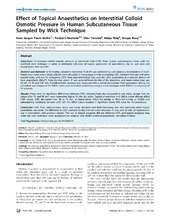| dc.contributor.author | Guthe, Hans Jørgen Timm | en_US |
| dc.contributor.author | Nedrebø, Torbjørn | en_US |
| dc.contributor.author | Tenstad, Olav | en_US |
| dc.contributor.author | Wiig, Helge | en_US |
| dc.contributor.author | Berg, Ansgar | en_US |
| dc.date.accessioned | 2013-03-25T13:11:10Z | |
| dc.date.available | 2013-03-25T13:11:10Z | |
| dc.date.issued | 2012-02-14 | eng |
| dc.Published | PLoS ONE 7(2): e31332 | eng |
| dc.identifier.issn | 1932-6203 | |
| dc.identifier.uri | https://hdl.handle.net/1956/6459 | |
| dc.description.abstract | Objectives: To measure colloid osmotic pressure in interstitial fluid (COPi) from human subcutaneous tissue with the modified wick technique in order to determine influence of topical application of anaesthetics, dry vs. wet wick and implantation time on COPi. Material and Methods: In 50 healthy volunteers interstitial fluid (IF) was collected by subcutaneous implantation of multi-filamentous nylon wicks. Study subjects were allocated to two groups; one for comparing COPi obtained from dry and saline soaked wicks, and one for comparing COPi from unanaesthetized skin, and skin after application of a eutectic mixture of local anaesthetic (EMLA®, Astra Zeneca) cream. IF was sampled from the skin of the shoulders, and implantation time was 30, 60, 75, 90 and 120 min. Colloid osmotic pressure was measured with a colloid osmometer. Pain assessment during the procedure was compared for EMLA cream and no topical anaesthesia using a visual analogue scale (VAS) in a subgroup of 10 subjects. Results: There were no significant differences between COPi obtained from dry compared to wet wicks, except that the values after 75 and 90 min. were somewhat higher for the dry wicks. Topical anaesthesia with EMLA cream did not affect COPi values. COPi decreased from 30 to 75 min. of implantation (23.2±4.4 mmHg to 19.6±2.9 mmHg, p = 0.008) and subsequently tended to increase until 120 min. EMLA cream resulted in significant lower VAS score for the procedure. Conclusion: COPi from subcutaneous tissue was easily obtained and fluid harvesting was well tolerated when topical anaesthetic was used. The difference in COPi assessed by dry and wet wicks between 75 min. and 90 min. of implantation was in accordance with previous reports. The use of topical analgesia did not influence COPi and topical analgesia may make the wick technique more acceptable for subjects who dislike technical procedures, including children. | en_US |
| dc.language.iso | eng | eng |
| dc.publisher | Public Library of Science | eng |
| dc.relation.ispartof | <a href="http://hdl.handle.net/1956/18710" target="blank"> Transcapillary fluid balance in children. Methodology and new clinical studies. To the interstitial space - and back again</a> | |
| dc.rights | Attribution CC BY | eng |
| dc.rights.uri | http://creativecommons.org/licenses/by/2.5/ | eng |
| dc.title | Effect of Topical Anaesthetics on Interstitial Colloid Osmotic Pressure in Human Subcutaneous Tissue Sampled by Wick Technique | en_US |
| dc.type | Peer reviewed | |
| dc.type | Journal article | |
| dc.description.version | publishedVersion | en_US |
| dc.rights.holder | Copyright 2012 Guthe et al. This is an open-access article distributed under the terms of the Creative Commons Attribution License, which permits unrestricted use, distribution, and reproduction in any medium, provided the original author and source are credited. | |
| dc.identifier.doi | https://doi.org/10.1371/journal.pone.0031332 | |
| dc.identifier.cristin | 945857 | |

